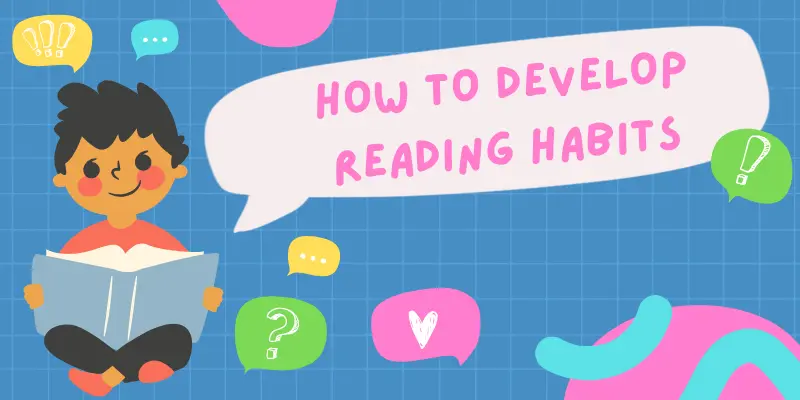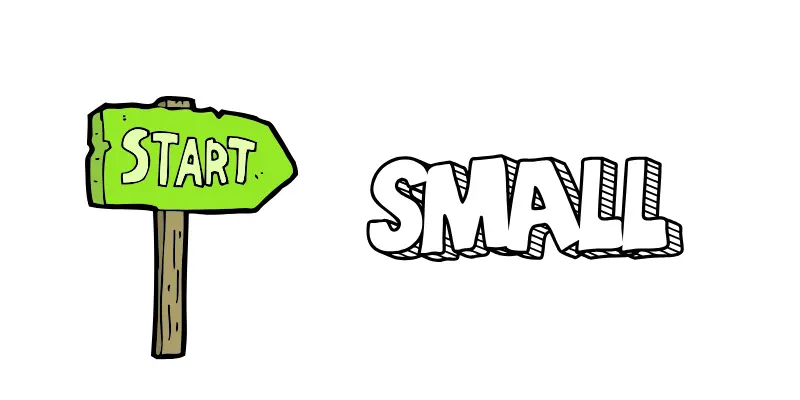How to Develop Reading Habits and Enjoy Every Page: A Psychology Backed Guide
Updated: 06 Jun 2025
320
Did you know that most people want to read more books but struggle to build the habit? Have you ever told yourself, “I really want to read more, but I just don’t have the time”? You’re not alone.
Studies show that about 1 in 4 adults don’t read any books in a year. The problem isn’t a lack of interest—it’s about finding time and building a simple, enjoyable routine. If you’ve ever felt stuck or distracted, you’re not alone.

The good news? You don’t need to read for hours each day to call yourself a reader.
In this blog post, you’ll find 15 practical, easy-to-follow tips that will help you develop a reading habit, one small step at a time.
Tips To Develop Reading Habits That Last
Now let’s talk about how we can fall in love with books:-
1. Start Small – Even One Page Matters
If you want to build a reading habit, start small. Many people try to read for hours from day one and quickly lose interest.

The best way is to begin with just one page or five minutes a day. This feels simple and removes the pressure to finish big chapters.
| 👉 Tip: |
|---|
Set a tiny goal like, “I’ll read one page before breakfast.” Small wins help you stay consistent. Over time, reading will feel easy and natural. |
2. Connect Reading to Your Daily Routine
A great way to remember your reading time is to link it to something you already do. This is called habit stacking.
For example, read right after your morning coffee, during your lunch break, or just before going to bed. When you tie reading to a regular part of your day, it becomes harder to skip.
| 👉 Example: |
|---|
“After I brush my teeth at night, I will read for 10 minutes.” |
3. Create a Cozy Reading Spot
Your reading space matters. Find a quiet, comfortable place where you can relax with your book. It doesn’t have to be fancy—just a soft chair, a small table, and good lighting can make a big difference.
| 👉 Tip: |
|---|
Keep your books close to your reading spot so it’s always easy to pick one up. |
4. Set Simple and Clear Reading Goals
Clear goals can keep you focused. Start with easy targets like “read for 10 minutes a day” or “finish one book this month.”

When your goals are simple, it’s easier to stick with them. Don’t worry about big numbers—just aim for steady, daily progress.
👉 Tip: Use a notebook or a reading app / smart learning tools to track the books you finish. Seeing your progress can keep you motivated to keep going.
5. Always Carry a Book With You
One easy way to fit reading into your busy life is to always have a book nearby. Keep one in your bag, on your phone, or try audiobooks.
| 👉 Tip: |
|---|
Use short waiting times—like bus rides or coffee lines—to read a few pages. These small moments add up quickly. |
When books are always within reach, you’ll find more chances to read throughout your day.
6. Mix Different Book Types
Sometimes, sticking to just one kind of book can feel boring. Try to mix things up by reading different genres like mystery, romance, self-help, or short stories. You can also read magazines, comics, or graphic novels.

Changing book types keeps your interest fresh and makes reading feel exciting instead of like a chore. If one book feels too heavy, switching to something lighter can help you stay on track.
| 👉 Pro Tip: |
|---|
Try reading a short story collection on busy weeks and a novel when you have more free time. This keeps the habit flexible and fun. |
7. Join a Reading Group or Buddy System
Reading can feel more fun when you share it with others. Join a local book club, find an online reading group, or simply ask a friend to read the same book as you.
When you discuss books with others, you stay motivated, and you’ll likely read more regularly. It’s easier to build a habit when you have someone to share your thoughts with. Plus, you might discover books you’d never choose on your own.
| 👉 Example: |
|---|
You can find free online book clubs on social media or join reading challenges on apps like Goodreads to connect with other readers. |
8. Set Social Media Limits
Scrolling through social media often takes up the time you could use for reading. Try setting small limits on your phone apps or create a “no-phone” time each day.

Replacing 10 minutes of scrolling with 10 minutes of reading can make a big difference. You don’t have to cut social media completely—just make a little space for books in your day.
| 👉 Pro Tip: |
|---|
Set your phone to “Do Not Disturb” for 30 minutes when you plan to read. You’ll be amazed at how much you can enjoy a book without notifications popping up. |
9. Track Your Reading Progress
Keeping track of your reading can make the habit stick. Use a simple notebook, a calendar, or a reading app to record what you’ve read and how much time you’ve spent.
Seeing your progress gives you a sense of achievement. It can also remind you how far you’ve come, even if you’re reading slowly. Little by little, you’re building a habit that lasts.
| 👉 Example: |
|---|
Try using a reading app like StoryGraph or Goodreads to mark the books you’ve finished and set simple monthly reading goals. |
10. Reward Yourself for Milestones
When you reach a small reading goal, celebrate it! Rewards can be simple—like enjoying your favorite snack, buying a new book, or watching an episode of your favorite show.

Giving yourself small rewards keeps the habit fun and exciting. It’s like telling your brain, “Reading is something to enjoy, not something I have to do.” These little celebrations help you stay motivated.
| 👉 Pro Tip: |
|---|
Set rewards for tiny goals like “read for five days in a row” to build momentum quickly and keep yourself excited about your progress. |
11. Choose Books That Truly Interest You
Sometimes, people try to read what they “should” read instead of what they actually enjoy. Pick books that match your interests. Whether it’s fantasy, history, or even cookbooks, what matters is that you like it.
Reading what excites you keeps the habit alive. It’s much easier to stick with books you love than books you feel forced to finish.
👉 Pro Tip: If a book doesn’t grab your attention after 20 pages, don’t be afraid to switch. Reading should feel fun, not like a chore.
12. Try Audiobooks for Busy Days
If you find it hard to sit down and read, audiobooks are a great option. You can listen while driving, cooking, or walking.
Audiobooks help you keep the habit going even on your busiest days. They’re perfect for people who learn better by listening or who want to enjoy stories on the go.
- Our best sounding Echo Dot yet – Enjoy an improved audio experience compared to any previous Echo Dot with Alexa for cle…
- Your favorite music and content – Play music, audiobooks, and podcasts from Amazon Music, Apple Music, Spotify and other…
👉 Example: Download free audiobooks from apps like Libby, which connects to local libraries, so you can listen without spending money.
13. Limit Distractions During Reading Time
A quiet space helps you focus. Try to reduce distractions like TV, phone, or loud music while reading.
Even 10 minutes of focused reading is better than an hour of distracted reading. Giving your book your full attention makes reading more enjoyable and helps you remember what you’ve read.
👉 Pro Tip: Use noise-canceling headphones or soft background music (like rain sounds) if your environment is noisy.
14. Make Reading a Relaxing Experience
Treat reading as a time to relax, not another task on your to-do list. Light a candle, make a cup of tea, or wrap yourself in a cozy blanket while you read.
When reading feels like a treat, you’ll naturally want to do it more. Making it part of your self-care routine can help you look forward to it.
👉 Example: Try reading right before bed to calm your mind and reduce screen time in the evening.
15. Be Patient with Your Progress
Building a reading habit takes time. Some days you’ll read a lot, and other days you might not read at all. That’s completely okay.
What matters is showing up again, even after missing a day. Habits grow with patience and steady effort.
👉 Pro Tip: Focus on consistency over perfection. Even reading two days a week is a win if you’re building the habit slowly.
7 psychology-based strategies for building sustainable reading habits
Here are 7 psychology-based strategies for building sustainable reading habits, each backed by solid research. These techniques help your brain form habits faster and make reading feel enjoyable—plus they improve your post credibility for both readers and search engines.
- Create If‑Then Triggers (Implementation Intentions). Make a clear daily plan—“If it’s 7 a.m., then I’ll read for 10 minutes”. Known as implementation intentions, this approach helps link a cue with an action, making the behavior more automatic.
- Use Small, Daily Repetition. Research suggests new habits take 66 days or more to form, depending on consistency and simplicity. Starting small (e.g., 5 minutes daily) and repeating it often builds stronger habits than half-hearted efforts.
- Leverage the Habit Loop: Cue → Action → Reward. Drawing on Charles Duhigg’s habit loop, pair a cue (like finishing lunch) with reading, then give yourself a small reward (a coffee break or praise). This cycle releases dopamine, reinforcing the habit.
- Opt for Event‑Based Cues Over Time‑Based. Studies show cues tied to events (e.g., “after lunch”) are more reliable than time-specific ones (e.g., “at 7 p.m.”) . It’s easier to remember the habit when it’s triggered by a routine you already do.
- Start with High Enjoyment. Habits stick best when you enjoy them. Research on pleasure reading among students confirms that enjoyment increases motivation and well‑being.
- Use Partial Reinforcement for Longevity. To make habits long-term, avoid constant rewards. Intermittent rewards are more effective at maintaining behavior over time. Celebrate some—but not every—reading session.
- Read Aloud (Production Effect). Reading aloud—or whispering the words—strengthens memory and engagement. This “production effect” helps retention more than silent reading alone.
Putting it all together:
- If it’s right after lunch, then I’ll read aloud a page, even for just 5 minutes.
- Reward yourself occasionally—maybe every third session—with something small.
- Stick with it daily, using cues you already have, and enjoy it!
These seven psychology-backed strategies will help readers of your blog build lasting reading habits. Let me know if you’d like help creating visuals or interactive tools around these insights!
Wrap Up
To wrap up, developing a reading habit is not about speed or pressure—it’s about finding joy in the process. By starting small, choosing books you love, creating a cozy reading space, and staying consistent, you can easily make reading a natural part of your day.
Remember, it’s okay to miss a day or switch books if something doesn’t click. The key is to enjoy the journey, not just the finish line.
Whether you’re reading for five minutes or an hour, every page counts. Celebrate your progress, explore different genres, and most importantly, be patient with yourself. Over time, these small efforts will grow into a powerful, lifelong habit. Happy reading!
FAQs
It usually takes about 2 to 3 months of regular practice to build a lasting reading habit.
It’s okay to stop and try a different book. Reading should feel enjoyable, not forced.
Yes! Audiobooks are a great way to enjoy stories, especially when you’re busy or on the go.
Even 5 to 10 minutes a day is enough to start. The key is to stay consistent.
The best time is when you can focus—like in the morning, during lunch breaks, or before bed.

Please Write Your Comments